Transparency is extremely important to us, so we are letting you know that we may receive a commission on some of links you click on from this page. See our disclaimer.
Last week we reported some good news: A MedPage Today report that “U.S. Adults, Kids Put Down The Sugary Drinks: Sugar-sweetened beverage consumption down, water intake up.”
The piece (and the news) is especially timely during November — American Diabetes Month.
The piece was based on a study titled “Trends in Beverage Consumption Among Children and Adults, 2003-2014” that was published in Obesity. A deeper look at the study provides more important insights that could apply to well-run workplace wellness programs and approaches to keep this downward trend going.
The study outlines how significant the problem is: “Sugar-sweetened beverages (SSBs) are a leading source of added sugar to the diet for adults and children in the United States. The consumption of SSBs is strongly linked to obesity, though some studies have found null results. On a given day, about half of adults and two-thirds of children consume at least one SSB. In recent years, SSB consumption has begun to decline; however, rates of SSB consumption have remained persistently higher for racial and ethnic minorities, who are also at higher risk for obesity.”
The conclusions offer strong encouragement for well-run workplace wellness programs to continue educating participants on the potentially harmful effects of sugar-sweetened beverages:
- Information helps: “This overall decline in both beverage and SSB consumption is consistent with previous literature, suggesting a recent ‘turning point' toward lower energy intake in the US diet, potentially attributable to widespread discussion and media coverage of the role of certain foods (e.g., SSBs) in promoting obesity, changes to food allowances within the Special Supplemental Nutrition Program for Women, Infants and Children, improvements to school feeding programs, and product reformulations by food manufacturers and retailers.”
- Awareness helps: “From an energy balance perspective, it is encouraging that children and adults are consuming fewer calories from beverages, as liquids have lower satiety and are less well compensated than calories from solid foods.”
- More effort is needed for various sociodemographic groups: “The differences in SSB consumption trends by sociodemographic characteristics were also notable. While NH white adults experienced declines in SSB consumption across almost all age groups, there were no significant changes for any age category of Mexican American and non-Mexican Hispanic participants or for NH black participants aged 20 to 39 years or 60 + years.”
- Effective programs — such as well-run workplace wellness programs — can help greatly: “Another way to encourage greater consumption of healthier beverages (such as water) could be through procurement policies, which place restrictions on the types of beverages that can be made available for purchase in places such as schools, worksites, or government institutions. These healthy beverage procurement policies may have the added benefit of catalyzing the beverage industry to reformulate beverages to meet a heathier profile (such as flavored water rather than soda).”




0 Comments